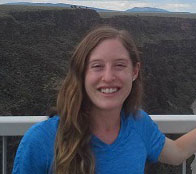Refining the Spatial and Temporal Signatures of Creep and Co-Seismic Slip Along the Southern San Andreas Fault Using Very High Resolution SfM Imagery, Coachella Valley, California

Chelsea Blanton
MS Candidate
Advisor: Dr. Tom Rockwell
Friday May 10th, 2019
CSL 422 – 8 am
watch Chelsea’s defense
Abstract
Structure from Motion (SfM) Photogrammetry, based on unmanned aerial vehicle (UAV) flights, was implemented along the southern San Andreas fault (sSAF) to acquire a dense, high-resolution topographic dataset from which to interpret fault-related offsets of small geomorphic features and to develop a model of late Holocene slip-per-event. This study better constrains slip estimates from recent earthquakes along the sSAF and combines new slip data with ages of past earthquakes from paleoseismic studies (Philibosian et al., 2011, Rockwell et al., 2018). We evaluate slip per event for paleoearthquakes which ruptured this segment of the sSAF and investigate the relationship between co-seismic slip events and aseismic creep. The data show that the Coachella Valley segment of the SAF likely follows a quasi-periodic recurrence model for large earthquakes. Statistical analysis of our offsets suggests at least 4 large surface rupturing events with average displacements of 2.7 – 2.9 m per event. Analysis also reveals small-scale offset clusters that we attribute to climate-modulated channel incision across the fault, followed by subsequent creep. These offset clusters support a creep rate of ~3 mm/yr at both Mecca Hills and Box Canyon for the past ~160 years.

